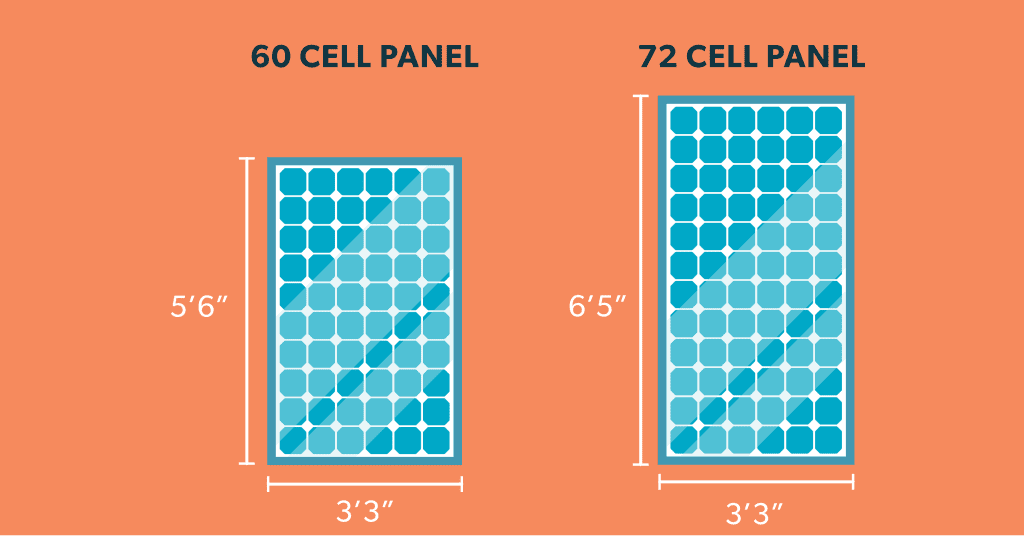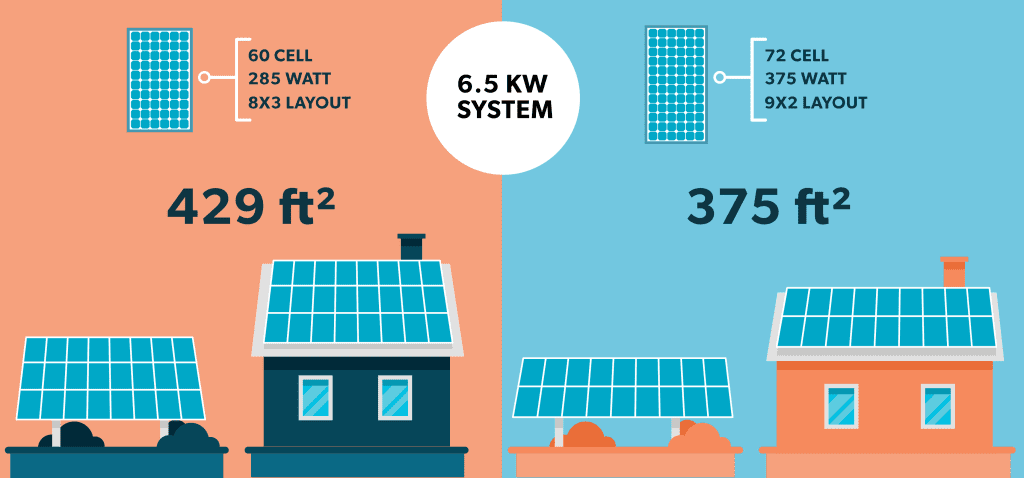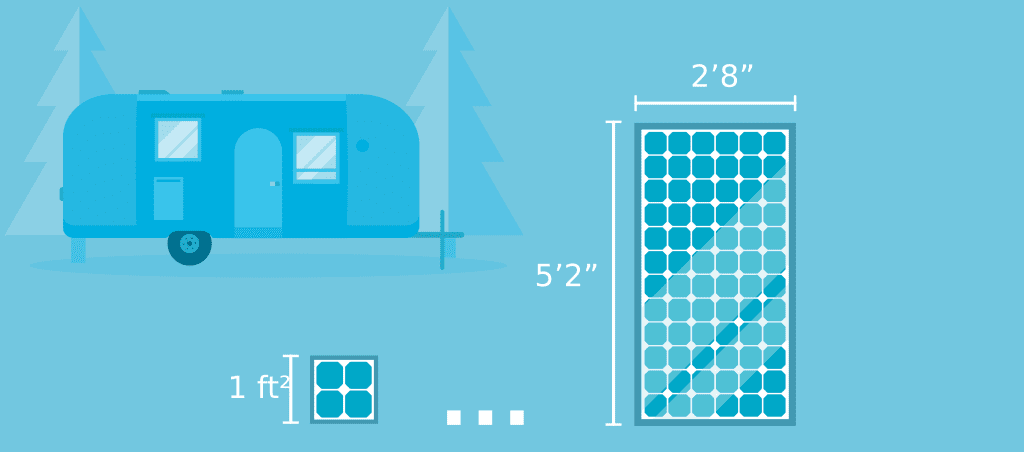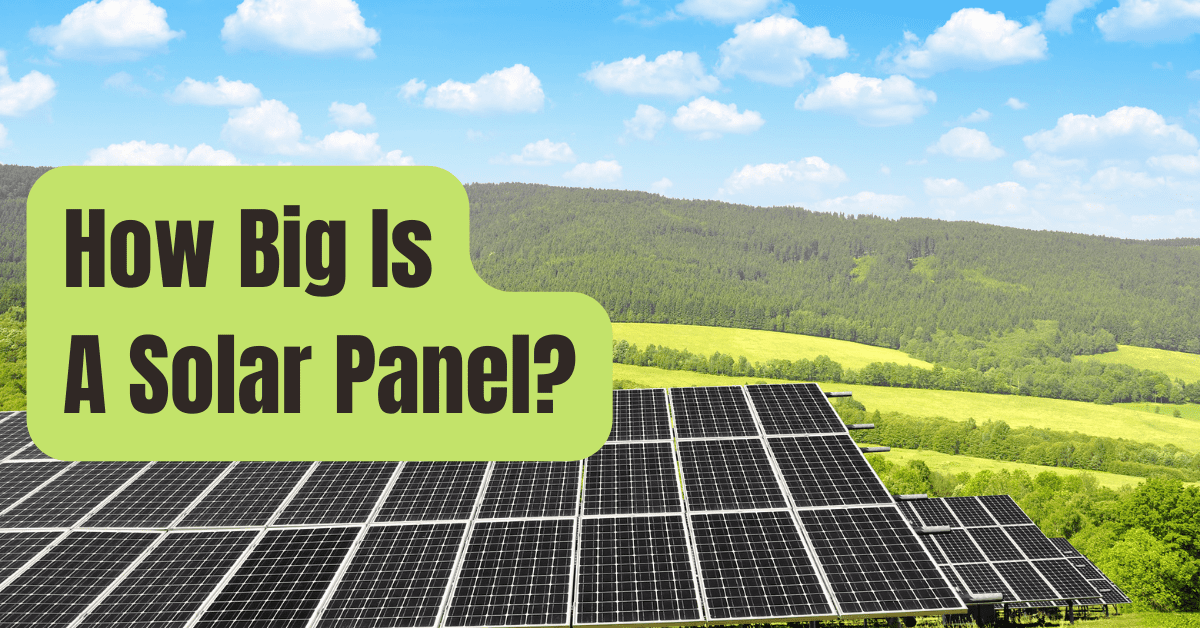Sizes of a Standard Solar Panel
60-cell and 72-cell solar panels are the two most popular types of conventional solar panels.
The typical measurements for each choice are:
- 60-cell panels: 39″ x 66″ (3.25 feet x 5.5 feet)
- 72-cell panels: 39″ x 77″ (3.25 feet x 6.42 feet)
When adopting solar, one of the first questions people have is, “Where am I going to construct my system?” Not many properties have enough area for solar arrays since they take up a lot of space.
This fast tutorial will discuss typical solar panel sizes and explain how to calculate the number of panels your system needs.
The system’s overall array size may then be calculated to determine how much space it will use on your property.
Dimensions of a Typical Solar Panel
60-cell and 72-cell standard solar panels are available in two widely used designs.
A single solar cell is 6″ x 6″ in size.
There is a 610 grid used to arrange 60-cell panels.
A 612 grid is used to arrange 72-cell panels, which are roughly a foot higher.
- 60-cell panels: 39″ x 66″ (3.25 feet x 5.5 feet)
- 72-cell panels: 39″ x 77″ (3.25 feet x 6.42 feet)
With or without an inch on each side, these are the typical solar panel sizes for most home and business installations.
(There will be some difference since different manufacturers utilize various frame sizes.)

Other panel size combinations are available, although they are far less typical.
However, the industry’s most popular panel sizes are by far the regular 60-cell and 72-cell panels.
Chart for Solar Panel Size
| Configuration | Width | Height | Depth |
|---|---|---|---|
| 60-cell | 39″ | 66″ | 1.3 – 1.6″ |
| 72-cell | 36″ | 77″ | 1.3 – 1.6″ |
| 96-cell | 41.5″ | 62.6″ | 1.38″ |
What Size is the Common Solar Array?
Every month, the typical American consumes 867 kWh of power.
A 6.5 kW solar array would be required to completely offset such use.
We presently have 60-cell solar panels in stock that range from 285W to 315W, and 72-cell solar panels in stock that range from 335W to 375W.
We may estimate the number of panels required to construct a 6.5 kW (6500-watt) system as follows:
- 6500W / 285W = 22.8 (23 panels)
- 6500W / 315W = 20.6 (21 panels)
- 6500W / 340W = 19.1 (20 panels)
- 6500W / 375W = 17.3 (18 panels)
18–23 panels, on average, make up a solar system, depending on the efficiency of the panels you use.
Here is a conversion of it to physical system size.
To get an idea of how much room the array could need, let’s compare the least efficient panels—285W/60 cells—to the most efficient ones—375W/72 cells:
375W 72-cell panels (9×2 array)
29.25 ft. x 12.83 ft. = 375.38 sq. ft.
285W 60-cell panels (8×3 array)
26 ft. x 16.5 ft. = 429 sq. ft.

An average-sized solar system will cover a total area of 375 to 429 square feet.
Either your roof or a ground mount on your property are options for mounting that equipment.
The panel wattage and array configuration will determine the precise size.
How Big Are Travel Trailer or Portable Solar Panels?
Small panels used for mobile or distant application are the other use case to consider.
These are the panels used for off-grid applications including solar-powered lamps, boats, and recreational vehicles.
Smaller panels exist in a variety of sizes, unlike typical 60- and 72-cell panels, which are standardized across the industry.
Small 5-watt panels use less than 1 square foot of area, but our Solarland SLP190 (a popular option for off-grid distant applications) is close to a full-size panel at 32″ x 62″.

Making the most of the little space you have available is key when choosing the panels for your boat or RV.
Although full-sized panels may be used on the road, most individuals with RVs or boats require a smaller alternative since they often lack the room to place them.
These panels typically have conventional output voltages of 12 or 24 volts.
In our post spotlighting the best portable solar panels for remote/mobile usage, we’ve explored a number of decent alternatives if you’re searching for panels for your RV or boat.
How Much Weigh Solar Panels?
Along with physical dimensions, people often inquire about the weight of solar panels.
It might be difficult to hoist panels onto your roof since they can be fairly heavy, particularly if you’re working alone.
We inform them that full-sized panels often weigh between 40 and 60 pounds as a general guideline.
Depending on the materials the manufacturer utilized, it differs a little.
The weight of some of the panels we have is shown in the following table:
| Product | Cell Count | Weight |
|---|---|---|
| Astronergy 365W | 72 | 48.06 lbs |
| Canadian Solar 325W | 60 | 42.3 lbs |
| Mission Solar 385W | 72 | 52 lbs |
| Solarland SLP120 | 36 | 23 lbs |
The true difficulty in lifting panels is not so much their weight as it is their bulk, which makes them difficult to handle.
A 60-cell panel may be carried by one person, but because 72-cell panels are taller than 6 feet, it is usually better to utilize two persons.
We urge everyone to err on the side of caution since they may easily wobble and lead you to lose your balance, particularly in windy weather.
You may also construct scaffolding and/or utilize a motorized lift to support the weight of the panels if you need assistance raising them onto your roof.










